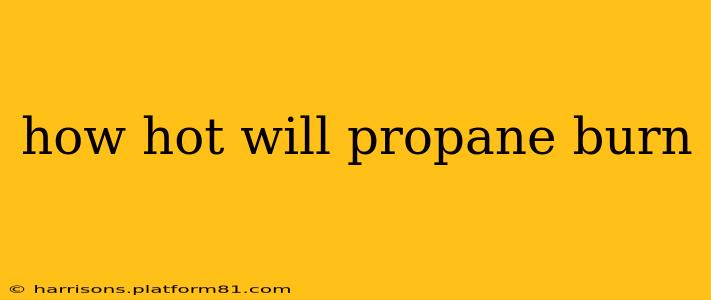Propane, a widely used fuel for heating, cooking, and various industrial applications, burns incredibly hot. But the exact temperature isn't a single number; it depends on several factors. Understanding these factors is crucial for safety and efficiency. This comprehensive guide will delve into the specifics of propane combustion temperatures, addressing common questions and concerns.
What is the typical burning temperature of propane?
The theoretical maximum adiabatic flame temperature of propane burning in air is approximately 3,690°F (2,032°C). This is a theoretical maximum, achieved under ideal, perfectly efficient combustion conditions. In real-world applications, however, this temperature is rarely reached.
What factors affect propane's burning temperature?
Several factors influence the actual burning temperature of propane:
-
Air-to-fuel ratio: The ideal air-to-fuel ratio for complete combustion is crucial. Too much air (lean mixture) results in a lower flame temperature, while too little air (rich mixture) also lowers the temperature and produces incomplete combustion, creating soot and carbon monoxide. Finding the optimal balance maximizes heat output.
-
Ambient temperature and pressure: Colder ambient temperatures can slightly reduce the flame temperature, while higher pressures can increase it. However, these effects are generally minor compared to the air-to-fuel ratio.
-
Burner design and efficiency: The design of the burner significantly impacts combustion efficiency and, consequently, the flame temperature. A well-designed burner promotes thorough mixing of propane and air, leading to more complete combustion and higher temperatures. Inefficient burners waste fuel and produce lower temperatures.
-
Presence of other gases: If other gases are present in the combustion mix, they can alter the flame temperature. For instance, the presence of inert gases like nitrogen can dilute the mixture and lower the temperature.
How hot does a propane torch burn?
Propane torches, used for various applications like soldering and weed control, typically achieve temperatures ranging from 1,975°F to 2,550°F (1,080°C to 1,400°C). The exact temperature depends on the torch design, fuel flow rate, and air mixture. These torches often utilize a concentrated flame to achieve higher temperatures than open-air combustion.
How hot does a propane stove burn?
Propane stoves, commonly used for cooking, generate much lower temperatures than torches. The flame temperature on a propane stovetop burner typically falls within the range of 800°F to 1,200°F (427°C to 649°C), depending on the burner setting and design.
What safety precautions should be taken when using propane?
Propane is a highly flammable gas, and proper safety precautions are essential:
- Proper ventilation: Ensure adequate ventilation when using propane appliances to prevent the buildup of carbon monoxide.
- Leak detection: Regularly check for propane leaks using soapy water. Never use a flame to detect leaks.
- Storage: Store propane cylinders outdoors in a well-ventilated area, away from ignition sources.
- Professional installation: Always have propane appliances installed and serviced by qualified professionals.
Conclusion
While the theoretical maximum flame temperature of propane is impressive, the actual temperature achieved varies significantly depending on several factors. Understanding these factors, particularly the crucial air-to-fuel ratio and burner design, is key to both maximizing the efficiency and ensuring the safe operation of propane-fueled equipment. Always prioritize safety when working with propane.
